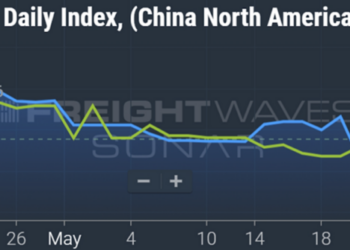Water levels on the Mississippi remain low after a brief surge earlier this month, but rates for moving grain by barge on the river continue to defy any upward push.
The National Weather Service reported Wednesday that levels on the Mississippi River at Memphis, Tennessee, stood at minus 9 feet. Levels are expressed relative to a baseline. A reading of minus 11.52 feet last month was the lowest since recordkeeping began. The latest data from the National Weather Service does show improvement at Memphis over the next several days.
That negative 9 foot measurement recorded Tuesday was down from negative 7.63 feet on Nov. 15 and down significantly from negative 4.81 feet on Nov. 6.
Although this year’s water levels are on par with those of 2022, another year when drought impacted flows, barge rates are well below last year and have been in a relatively narrow range in recent weeks.
According to the U.S. Department of Agriculture’s weekly Grain Transportation Report, the grain transport cost indicator for barge movements on the Mississippi was 275 for the week ending Nov. 15, the most recent figure available. The indicator is a percentage of the 2000 base year so 275 would be 275% of the base year.
A year ago, that indicator was 670. A month ago, it was 326 in the week ended Oct. 18 and was 366 a week before that. And for the week ended Oct. 19, 2022, it was a whopping 1,077.
There is other data that reflects that the barge industry is finding ways to move grain on the Mississippi and its tributaries without racking up enormous costs, many of which also are at low levels.
For example, the USDA data said in the week ended Nov. 11, barged grain movements were 722,661 tons. That was an 8% increase from the prior week and 22% more than a year ago.
One potential reason for the ability of barge rates so far to defy the river’s reduced capacity is less grain is being exported. In the grain report published Nov. 9, the USDA quoted numbers on export sales that showed reductions in exports of wheat, corn and soybeans compared to last year, as much as 13%. If the grain doesn’t need to make it all the way down to New Orleans for export and instead remains in the U.S. for storage or processing, that could be putting less pressure on barge rates.
In its Oct. 19 Grain Transportation Report, the USDA noted the weak export market and the potential impact it was having on barge rates.
“Up from earlier in the year, barge rates are still below average — likely reflecting low corn and soybean export sales to China,” the report said. “Despite low water levels in the Panama Canal, resulting in limited daily transits, ocean freight rates from the U.S. Gulf to Japan remain below average.”
Mike Steenhoek, executive director of the Soy Transportation Coalition, has become one of the go-to voices on Mississippi River transport conditions. Earlier this month, when the river was rising, he sent an email blast noting that “due to the improved conditions, barge companies have increased the amount of freight (soybeans in our case) they are loading per barge.
“Channel width has also improved, allowing more barges to be attached together to form one unit,” he wrote. “That being said, we continue to see restrictions of approximately 15-25% due to the continued low water conditions.”
In a follow-up email, Steenhoek said this week there has been little change since that report. “Barge companies continue to light load their barges and reduce tow sizes,” he said. “This obviously remains a concern for agriculture.”
American Commercial Barge Lines (ACBL), one of the biggest barge operators on the Mississippi, publishes regular updates on river shipping conditions. According to those reports, despite the continued low water levels, by some metrics shipping has improved.
For example, in its daily river conditions report for Oct. 19, ACBL reported that loading drafts northbound and southbound between Cairo, Illinois — where the Ohio River joins the Mississippi — and Vicksburg, Mississippi, were cut 28% and were reduced 24% between Vicksburg and the Gulf of Mexico.
But in an update published Tuesday, the reduction was 24% northbound and 16% southbound between Cairo and the Gulf. ACBL said that results in a reduction of 400 to 600 tons per barge.
Tow size limitations between the dates of those two reports increased slightly during that time, with some six-wide barges permitted. The limitation a month earlier was five-wide barges and that limitation does remain in effect for some shipments, ACBL said.
More articles by John Kingston
STB’s Oberman rips into Union Pacific CEO Vena
Estes execs recap hack experience in unusual video presentation
3PLs get fresh legal win in fight to block liability in truck accidents
The post Mississippi River isn’t rising but barge rates aren’t getting any higher appeared first on FreightWaves.













